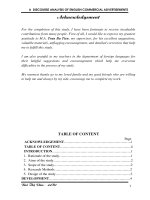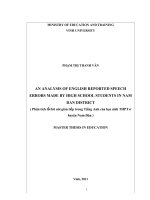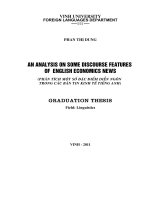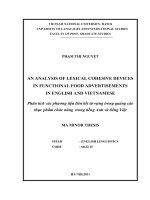an analysis of lexical cohesion in document of the textbook of english for geology = phân tích liên kết từ vựng sử dụng trong những tài liệu của giáo trình tiếng anh chuyên ngành địa chất tt
Bạn đang xem bản rút gọn của tài liệu. Xem và tải ngay bản đầy đủ của tài liệu tại đây (497.12 KB, 10 trang )
VIETNAM NATIONAL UNIVERSITY, HANOI
UNIVERSITY OF LANGUAGES & INTERNATIONAL STUDIES
FACULTY OF POST - GRADUATE STUDIES
****************
NGUYỄN THỊ MIỀN
An analysis of lexical cohesion in documents of the
textbook of English for geology
PHÂN TÍCH LIÊN KẾT TỪ VỰNG SỬ DỤNG TRONG NHỮNG TÀI
LIỆU CỦA GIÁO TRÌNH TIẾNG ANH CHUYÊN NGÀNH ĐỊA CHẤT
Field: English Linguistics
Code: 60 22 15
MA course: 18
Hanoi – 2011
VIETNAM NATIONAL UNIVERSITY, HANOI
UNIVERSITY OF LANGUAGES & INTERNATIONAL STUDIES
FACULTY OF POST - GRADUATE STUDIES
****************
NGUYỄN THỊ MIỀN
AN ANALYSIS OF LEXICAL COHESION IN DOCUMENTS
OF THE TEXTBOOK OF ENGLISH FOR GEOLOGY
PHÂN TÍCH LIÊN KẾT TỪ VỰNG SỬ DỤNG TRONG
NHỮNG TÀI LIỆU CỦA GIÁO TRÌNH TIẾNG ANH
CHUYÊN NGÀNH ĐỊA CHẤT
Field: English Linguistics
Code: 60 22 15
MA course: 18
Supervisor: Đặng Ngọc Sinh, MA
Hanoi – 2011
iv
TABLE OF CONTENTS
CANDIDATE’S STATEMENT i
ACKNOWLEDGEMENTS ii
ABSTRACT iii
TABLE OF CONTENTS iv
LIST OF TABLES viii
ABBREVIATIONS viii
PART A: INTRODUCTION Error! Bookmark not defined.
1. Rationale Error! Bookmark not defined.
2. Scope of the study 2
3. Aims of the study 2
4. Methods of the study 2
5. Design of the study 3
PART B: DEVELOPMENT 4
Chapter 1: THEORETICAL BACKGROUND 4
1.1. Background knowledge of English for specific purposes (ESP) 4
1.1.1. Concept of ESP and its characteristics 4
1.1.2. English for geology (EG) 6
1.2. Cohesion and Coherence 6
1.2.1. Concept of cohesion 6
1.2.2. Cohesion vs Coherence 6
1.2.3. Main types of Cohesion 7
1.2.3.1. Grammatical cohesion 7
1.2.3.2. Lexical cohesion 9
Chapter 2: LEXICAL COHESIVE DEVICES ANALYZED IN “ESP TEXTBOOK
IN DEPARTMENT OF MINERAL RESOURCES”. 11
v
2.1. General description of EG text 11
2.1.1. Definition of EG 11
2.1.2. Some features of EG 11
2.2. Cohesion and structure of each unit in EG textbook 11
2.2.1. Text 12
2.2.2. Diagram and figure 12
2.2.3. Vocabulary 12
2.3. Lexical cohesion 12
2.3.1. Reiteration 12
2.3.1.1. Repetition 13
a. Repetition of Nouns/ Noun Phrases. 14
b. Repetition of different parts of speech 16
2.3.1.2. Synonym 17
2.3.1.3. Antonym 20
2.3.1.4. Super-ordinate 22
2.3.2. Collocation 23
Chapter 3: MAJOR FINDINGS AND IMPLICATIONS FOR TEACHING EG
EFFECTIVELY 25
3.1. Findings 25
3.1.1. The features of EG texts 25
3.1.2. Lexical cohesion used in EG texts 25
3.1.3. Survey questionnaires 26
3.1.3.1. Teachers and students’ knowledge of ESP especially EG 27
3.1.3.2. Teachers and students’ awareness to LCD in texts of EG 30
3.1.3.3.Teachers and students’ targets and present situation 32
3.1.3.4. Problems in teaching and learning EG 33
vi
a. Difficulties of teachers in teaching EG 33
b. Difficulties of students in learning EG 34
3.2. IMPLICATIONS FOR TEACHING EG EFFECTIVELY 35
3.2.1. Teachers 35
3.2.2. Learners 37
3.2.3. Materials 37
PART C: CONCLUSION 39
Suggestions for further study 39
REFERENCES 41
APPENDIX 1 I
APPENDIX 2 III
APPENDIX 3 V
APPENDIX 4 X
1
Abstract
This dissertation provides some typical issues around English. In taking this
approach, two small aspects of language concerned in this study are English for Specific
Purposes(ESP) and Functional Grammar(FG). It is said that this study is a combination of
the Geology in English and analysis based on theory of FG. On the one hand, ESP supports
readers to get reading comprehension skill; on the other hand, FG is one branch of
Grammar in which Lexical Cohesive Devices(LCD) play a significant role in making the
text in both cohesion and coherence. It is these interesting features that the writer decided
to pick out this research with the hope that it would be useful for both the job of teachers
and the study of students.
To clarify the study, the qualitative and quantitative methods were used regularly. In the first
part providing the theory related to the thesis and the conclusion, the qualitative one was
applied a lot. Besides, the methods of description, analysis and statistic in linguistics with
quantitative one are pretty popular in chapter 2 and chapter 3.
Based on most of references found, all the necessary theory gradually worked out.
Moreover, to make the research reliable and persuasive, doing statistics of the data in
survey questionnaires gave the summary as the hypothesis. The analysis and findings of
the research are the most prominent parts; and the principal theoretical outcomes of the
work are as follows: First, the study shows that EG is one branch of ESP which is a useful
subject like English. Secondly, this dissertation also exploits the distinction between
cohesion and coherence. Third, the thesis indicates the overview of Cohesive Devices
including LCD. Fourth, the writer claims the existence of LCD and the role of LCD in the
texts. Fifth, some major problems in both teaching and studying EG are raised based on
the analysis of survey questionnaires Finally, focusing the study on problems, the obvious
findings are stated and led to some suggestions.
As a result, although the scope of the study is not large, it partly raises some ways
to make EG more interesting and worth-studying, some useful solutions for teachers to
work more effectively and students more interested in studying both English and EG. In
short, the findings indicate that not only textbook but also teaching and learning activities
could be enhanced better and better when they make use of
Lexical Cohesive Devices according to FG. It is obvious that FG features including
Cohesive Devices play an important role in studying English.
2
PART 1: INTRODUCTION
1. Rationale
This dissertation emphasizes the LCD as one prominent feature of FG which are
really worthfocusing when they are put in ESP texts. It is reasonable that this study will
cover a number of concepts (ESP, EG, Cohesion, Coherence, Cohesive Devices, LCD)
within the single constrained knowledge. This work established clearly-defined links
between linguistics and science. Moreover, since the geological advances which make it
possible to do this owe a great deal to this work, the transition from generative grammar to
functional grammar can be comparatively straightforward one. Although the author has not
attempted to deal exhaustedly with all the problems of teaching and studying EG, the
current work covers those issues which partly contribute to enhance the present situation.
Being aware of the necessity of studying EG in Department of Mineral Resources,
Faculty of Geology, University of Mining & Geology(DMR, FG of UMG) , EG is
arranged to be a compulsory subject, however, it seems to be nightmare to most of students
due to many reasons which are from the different aspects like materials, textbook designs,
syllabi, facilities, ect. Encountering the same situation, University of Mining & Geology
also expects the suitable method to help students study effectively and apply on the future
jobs flexibly.
2. Scope of the study
Due to the limited time and scope of a minor M.A thesis, this study only analyzes
Lexical Cohesive Devices in some texts from the ESP textbook in DMR, FG of UMG.
Therefore, it is reasonable to cover only enough number of typical texts to make the study
reliable. In order to be reliable, two survey questionnaires were handed out to five English
teachers and fifty forth year students studying in DMR, FG of UMG.
3. Aims of the study
The aims of this study are to work out the following features:
1. Overview of the ESP and EG.
2. Clarification of Cohesion and Coherence.
3. Main types of Cohesion.
4. Analysis in “ESP textbook in department of mineral resources”.
3
5. Statistics of questionnaires to work out the findings.
6. Problems in teaching and studying EG based on the findings.
7. Implications for teaching EG effectively and some suggestions for further
study.
4. Methods of the study
In order to catch up with the targets of this study, it is indispensable to apply the
appropriate methods which are both qualitative and quantitative approaches. To the detail,
the methods of description, statistics and analysis are applied flexibly by handing out the
survey questionnaires, analyzing them and collecting the data from both nine typical texts
and two survey questionnaires.
In this study, with a view to examine the material currently used at DMR, FG of
UMG in relation to the course requirements, much attention is paid to the analysis of the
syllabus and the material itself. These analyses were based on Hutchinson and Waters’
criteria on material evaluation (1987) and Halliday and Hasan’s features on lexical
cohesive devices used in material.
5. Design of the study
This study is divided into three main parts:
Part A: Introduction
The first part mentions the rationale, aims, scope, methods and design of the study.
Part B: Development
This part also consists of three smaller parts which are labeled by each chapter.
Chapter 1 goes over the theoretical background of the research containing two
significant terms:
(1) Overview of ESP and EG
(2) Cohesion and Coherence
Chapter 2 puts across lexical cohesive devices in the chosen texts of EG from the
ESP textbook at Department of Mineral Resources, Faculty of Geology, University of
Mining & Geology.
4
Chapter 3 indicates some major findings of studying EG and suggests some
meaningful implications to reform teaching and studying ESP, especially EG more
effectively.
Part C: Conclusion.
The last part shows the summary and touches on the further study
PART 2: DEVELOPMENT
Chapter 1: theoretical background
This chapter sets out in detail all the knowledge which is foundational to the whole
work related to the title consisting of concepts of ESP, EG, cohesion, coherence, lexical
cohesive devices.
Chapter 2: Lexical cohesive devices analyzed in “Esp
textbook in department of mineral resources”.
The first part of this chapter reports the description of EG in general before coming
into the specification of cohesion used in texts. The second parts showed the frame of each
unit. To the detail, in the main part, the writer pays attention to analyze two major
categories of lexical cohesive devices: reiteration and collocation in the lights of occurence
and analysis.
Chapter 3: Major findings and implications for teaching
eg effectively
Basing on several difficulties of the students analyzed in the findings, basing on the
opinions about the solutions of the English teachers at DMR, FG of UMG and on the
author’s study on theory of teaching and learning, some suggestions to overcome these
difficulties will be presented.
This chapter also has made some suggestions to reduce difficulties that the students
at DMR, FG of UMG encounter when learning EG. It is really not easy to overcome
these difficulties, thus, in order to improve the situation, students must work very hard and
have appropriate learning methods. Besides, they must be flexible and adaptable to
improve language skills.
5
PART 3: CONCLUSION
EG seems to be difficult for most students to understand absolutely. It challenges
teachers to find the most suitable way to teach EG well and students to seek the most
effective way to study EG. It will, however, take time, money, and a combined effort on
the part of many people consisting of teachers, students, and designers of the textbook. It
is the reason why this minor thesis is done with expectation that the author can give
contribution to
- Provide an overview of lexical cohesive devices with their usage in the EG texts,
and theory of both ESP and EG. Then teachers can pick up some appropriate to teach well
and students can be aware of them and eager to learn EG.
- Analyse LCD to point out the most important devices in texts which play a vital
role in making texts coherence, it is said that Repetition and Collocation are two most used
devices in the lexical cohesion. Based on these devices, teachers apply them as tools to
teach EG more effectively, otherwise, students recognize what to focus on and feel
studying EG easier.
- Show some typical difficulties that teachers and students have to encounter and
suggest some useful ways in both teaching and studying with the hope that they will
overcome and choose the better ways to follow. As a result, teachers, certainly, teach better
and better, while students study more and more interestedly even more and more
effectively. In the end, the author raises some suggestions for further study.









